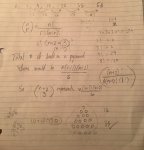[FONT="]In the diagram*, the first arrangement contains 1 ball, the second arrangement contains 4 balls, and the third arrangement contains 10 balls, forming the sequence: 1, 4, 10... [/FONT]
[FONT="](a) Determine the 4th, 5th, and 6th terms in this sequence. [/FONT]
[FONT="](b) Find an expression of the form nCr for the kth term of the sequence.
*I don't have a picture of the diagram on hand, but each of the next arrangements looks like it's placed underneath the first arrangement (4 balls placed under the first, and so on).
I've been stuck on this question for ages, but still not sure how to even approach it. I asked my tutor about it, but ran out of time before they could explain it to me properly. Basically, I came away with a sheet of their scribbles that makes little sense to me. If anyone could help me make sense of them, or offer any other help, it would be greatly appreciated! Here are some of the notes I have from my teacher about this problem:
[/FONT]

[FONT="](a) Determine the 4th, 5th, and 6th terms in this sequence. [/FONT]
[FONT="](b) Find an expression of the form nCr for the kth term of the sequence.
*I don't have a picture of the diagram on hand, but each of the next arrangements looks like it's placed underneath the first arrangement (4 balls placed under the first, and so on).
I've been stuck on this question for ages, but still not sure how to even approach it. I asked my tutor about it, but ran out of time before they could explain it to me properly. Basically, I came away with a sheet of their scribbles that makes little sense to me. If anyone could help me make sense of them, or offer any other help, it would be greatly appreciated! Here are some of the notes I have from my teacher about this problem:
[/FONT]

